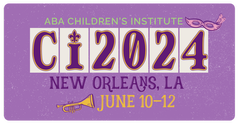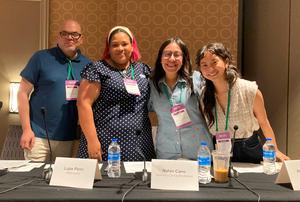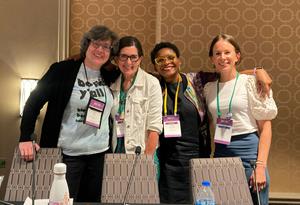 On the first day of the 2024 Children's Institute in New Orleans, the American Booksellers Association dedicated two bookseller panels to publisher-focused education: Booksellers Present on Children's Events in the 2020s and Middle Grade Market Discussion. The intention of the events panel was to show how events (virtual, hybrid, and in-person) have evolved since the onset of Covid-19, investigate factors that impact the needs of bookstores and customers in relation to events and school visits, and discuss ways to cultivate cross-industry collaboration. In the middle-grade market space, booksellers spoke about the recent decline in middle-grade readership, shared trends bookstores are seeing, suggested ideas for addressing the issue, and invited audience members (both publishers and booksellers) to collaborate on ideas.
On the first day of the 2024 Children's Institute in New Orleans, the American Booksellers Association dedicated two bookseller panels to publisher-focused education: Booksellers Present on Children's Events in the 2020s and Middle Grade Market Discussion. The intention of the events panel was to show how events (virtual, hybrid, and in-person) have evolved since the onset of Covid-19, investigate factors that impact the needs of bookstores and customers in relation to events and school visits, and discuss ways to cultivate cross-industry collaboration. In the middle-grade market space, booksellers spoke about the recent decline in middle-grade readership, shared trends bookstores are seeing, suggested ideas for addressing the issue, and invited audience members (both publishers and booksellers) to collaborate on ideas.
Nahin Cano of the Seminary Co-Op Bookstore in Chicago, Ill., Angie Zhao from bbgb in Richmond, Va., Lupe Penn of Bookmarks in Winston-Salem, N.C., and Brein Lopez from Children's Book World in Los Angeles, Calif., started the event panel by noting several post-pandemic realities: there has been a decrease in early and middle-grade readers, as well as a slide in reading ability and reading preparation for young kids; children's knowledge of bookstores has decreased; and many pandemic benefits families relied upon have run out. With these new realities, the panelists said, there are four main things bookstores and the publishers who work with and support them need to reevaluate when it comes to events and school visits: event size and outside venue requirements; pre-sale expectations to support access; touring schedules and academic calendars; and publisher transparency.

|
|
| (l.-r.) Brein Lopez, Children's Book World, Los Angeles; Lupe Penn, Bookmarks in Winston-Salem, N.C.; Nahin Cano, Seminary Co-Op Bookstore in Chicago; Angie Zhao, bbgb in Richmond, Va. | |
Most of the discussion between the panelists and members of the audience revolved around school visits, the need for transparency, and the importance of publishers having a working knowledge of when schools open and close across the country. Lopez noted that pub dates are a real challenge: "Publishers take their best books and publish them all on September 3. School visits can't happen on September 3!" Instead, he said, the best time to have an author touring schools is after the book has had some time to circulate and grow an audience among the students.
Some suggestions from the panelists included leaning into hybrid models for events: Zhao, Penn, and Cano all said they create forms with a QR code that can be sent home to the students' caretakers. They then build a webpage specifically for the author visit, allowing them to coordinate behind the scenes. This model, Penn said, ends in better sales for the stores. "Parents can send in cash, check, or use the QR code... allowing for significantly more purchases than it did previously." The panelists also noted the success they've achieved through "floating" meet and greets. "Our goal and mission are to ignite the love of reading," Penn said. In the floating meet and greets Penn has done, the middle-grade author is in attendance and there are activities for kids and for caretakers. This allows people to come in when they want, leave when they want, and no child has to sit quietly and be on their best behavior for the author.
The booksellers asked publishers to set author expectations: outside events are expensive, Cano said, and it's important to consider whether the need and the market are there. Lopez added: "Be as frank with your authors as we are as with you. You want people to come into the store--as opposed to an outside event--because they'll buy more books!" They noted that it's difficult to run YA events, but that publishers could use TikTok or Instagram to publicize small meetups to activate communities of readers. And they requested publisher websites list the indie bookstores as a first place to purchase books, especially when the author is one who specifically focuses on signing materials and promoting their local indies. One additional note from Lopez: "Ask the author to give us a 30-second reel that says, 'I am coming to your school soon.' " That video, he said, can be used across many forms of media and act as a draw for children and caretakers.
 |
|
| (l.-r.) Cathy Berner, Blue Willow Bookshop, Houston, Tex.; Cynthia Compton, 4 Kids Books & Toys, Zionsville, Ind.; Kathy Burnette, Brain Lair Books, South Bend, Ind.; Brenna Connor, Circana | |
The Middle Grade Market Discussion focused on readers between the ages of nine to 12 and included Kathy Burnette of Brain Lair Books in South Bend, Ind., Cynthia Compton from 4 Kids Books & Toys in Zionsville, Ind., Cathy Berner of Blue Willow Bookshop in Houston, Tex., and Brenna Connor of the consumer data company Circana. Connor began by stating that young reader and middle reader are posting the steepest declines year over year, but middle-grade readers are the only group posting declines below pre-pandemic years. "Thank you for very interesting and disturbing trends," Berner said.
Compton and Burnette both listed their top concerns. Compton focused on: a huge decline in hardcover sales ("We've hit the scary number.... Sticker shock happens at $18" and any book "over 225 pages is a deal breaker."); growth in graphic novel reading has segmented middle-grade readers away from more traditional novels, meaning that, if they're not jumping into a series at the age-appropriate level, they're never going to pick that story up later; and parents with more than one child have set expectations for what their child should be reading, which means they have opinions and ideas about what is an appropriate title for their young reader.
Burnette's major concerns mostly aligned with Compton's, with a specific focus on paperback books: "We need more series that start in paperback"--hardcovers are pricing young readers out. People are looking for paperbacks in almost every section, she said, with sticker shock setting in around $16 for paperbacks. There also needs to be fewer graphic novels in hardcover--graphic novels, she said, should always be paperback. And, as Compton mentioned, middle-graders simply don't have the reading stamina for something that is 300 pages long.
Connor pointed out additional data about consumer spending. She said that conflicting macroeconomic factors are impacting consumer spending: while some pressure on wallets is easing (inflation slowing, strong labor market), consumer packaged goods prices are still high, and debt is at record levels. Beyond that, headwinds such as a declining population rate and parents facing difficulties that other consumers aren't facing (like the end of SNAP benefits, childcare grants, and a lack of Medicaid continuity) are all impacting the children's market. Simply, all middle-grade formats are down, with trade paperback contributing to more than two-thirds of the middle-grade declines. "Everything is in decline," Connor said, "so it's a bit doom and gloom."
Connor noted that the top trends in adult fiction sales can also be seen in middle-grade titles. Adults are largely buying romantasy (such as Rebecca Yarros and Sara J. Maas), followed by thrillers and sci-fi. Pockets of growth in middle-grade can be found in similar areas, such as dragons (led by Wings of Fire series and Dragon Girl), adventure stories (series like Percy Jackson, I Survived, Spy School), robots (Wild Robot series, A Rover's Story, Transformers), and wilderness stories (The Eyes and the Impossible, Hatchet, A Horse Named Sky). There has also been a strong uptick in demand for Spanish-language titles, picture book through YA.
Overall, the panelists had suggestions on how publishers can help indies sell books. Marketing support like a value-add (pens, bookmarks, special items with purchase) can be hugely helpful; virtual event opportunities that include packages to pitch to school partners can increase sales; more accessible price points will reduce sticker shock; simultaneous Spanish-language and paperback releases open accessibility; and limited editions and other exclusives excite readers. The booksellers also expressed their sincere appreciation for ARCs--"We know how much they cost," Berner said, but they are hugely useful. "Please keep spending money on ARCs." --Siân Gaetano, children's and YA editor, Shelf Awareness

